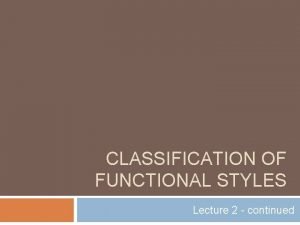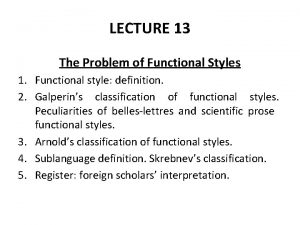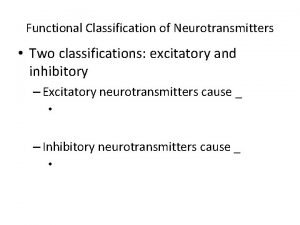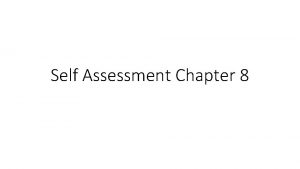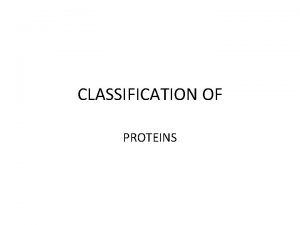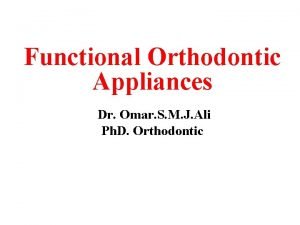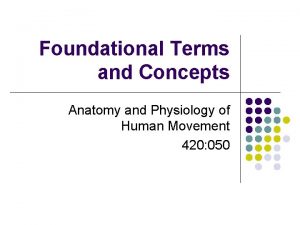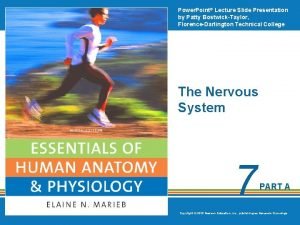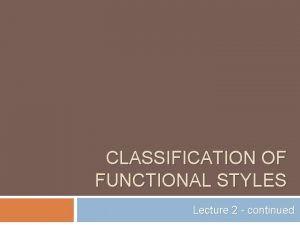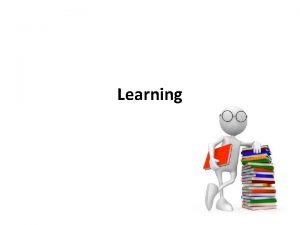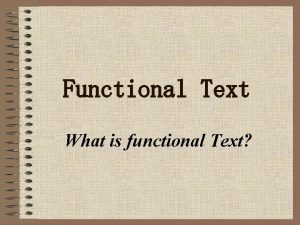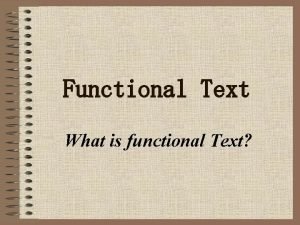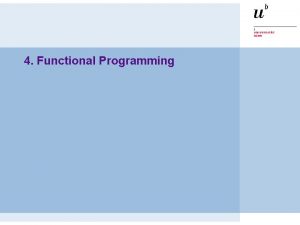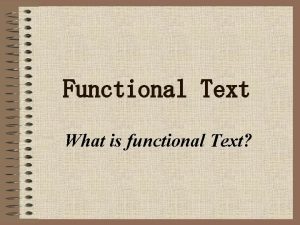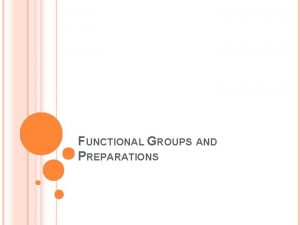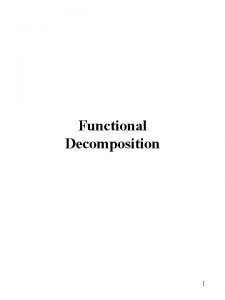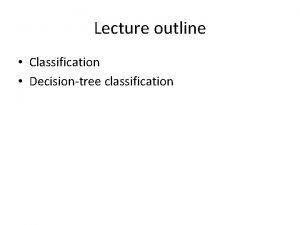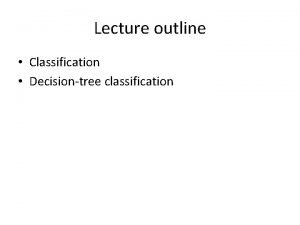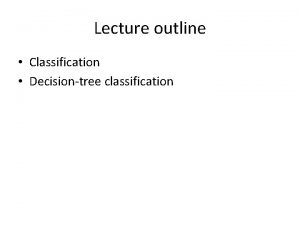CLASSIFICATION OF FUNCTIONAL STYLES Lecture 2 continued The





























- Slides: 29

CLASSIFICATION OF FUNCTIONAL STYLES Lecture 2 - continued

The publicistic style

The publicistic style Includes: � the style of newspaper and magazine articles, � essays, � oratorical speech � the style of radio and TV commentaries. Oral + written form Aim: to convince + to cause to accept

The publicistic style Peculiarities: � logical argumentation + emotional appeal = (scientific prose and belle-lettres style). � the emotional appeal – the use of words with emotive meaning + the use of stylistic devices (not fresh or genuine!) � the form of a monologue, � the coherent and logical syntactical structure � careful paragraphing, extended system of connectives � a great number of literary and bookish words.

Newspaper and Magazine Articles The aim: � interpret the news � comment on the events of the day � convince [the reader that …] Vocabulary: � terms (political, economic, etc. ); � newspaper clichés; � emotionally coloured vocabulary; � stylistic devices.

Essays short literary articles on philosophical, aesthetic or literary subject; never go deep; individual (often in 1 st person); very popular in the 18 th cent. : � the principal literary form, � written on important topics of the day, � often criticizing the short-comings of the political and social system in England.

Essays Features: � brevity of expression; � the use of 1 st person singular, personal approach; � the use of emotionally coloured words; � the use of epigram, paradoxes, aphorisms.

Oratorical Speech Includes : � parliamentary discourse, � speeches at Congress, � sermons, � orations, � speeches on solemn public occasions. Aim – to convince the audience and evoke an immediate desired reaction.

Oratorical speech Features of the oral speech: � the use of direct address (My Lords! Mr. Chairman! Ladies and Gentlemen!); � the use of contractions (I’ll, don’t); � the use of pronouns I and we; � the use of colloquial words and phrases, � the use of alliteration.

Oratorical speech The speaker wants: � to keep up the interest of the audience and hold it in suspense, consequently: emotionally coloured words; lexical and syntactical TRITE stylistic devices; repetition; allusions (to contemporary or historical events, to wellknown people, to literary characters, mythology and the Bible; used to draw the historical parallels and to confirm the statement).

Oratorical speech Syntactical features – � the sentences are long, can contain many dependent clauses and parenthetical clauses; � the use of gradations: Such a claim was all a part, a trick, a trap to provide the Republican party with a scapegoat at that time; � antithesis, rhetorical questions, exclamatory sentences, suspense: We fought Lexington to free ourselves. We fought Gettysburg to free others. (antithesis, parallelism, repetition)

Oratorical speech Rhetorical questions � draw the attention of the audience � and break the monotony of a series of declarative sentences, � have a strong emotive colouring (the speaker strives to call for a sympathetic reaction on the part of the listeners); � fulfill the function of a statement, not a ? Non-rhetorical Q. are also effective.

The publicistic style Summary � The use of direct address and 1 st person pronouns. � A rather wide use of connectives. � The abundant use of expressive and emotive words. � The use of tropes, especially sustained metaphors and similes. � The use of traditional set expressions and clichés. � The use of colloquial vocabulary.

The problem of colloquial style

The colloquial style informal speech of everyday conversation. The 1 st problem – classification: can it be regarded as a functional style? - I. R. Halperin (functional styles belong only to the written variety of the literary language) + I. V. Arnold, Y. M. Skrebnev, V. A. Maltsev

The colloquial style literary colloquial (литературно-разговорный); unceremonious (фамильярно-разговорный); popular speech/ common parlance (просторечье). - our everyday means of communication.

Peculiarities 1. Typified constructions -> speech almost automatic: � social phrases: greetings, words of parting; introductions and wishes; congratulations, requests, thanks, apologies, assent and dissent, hesitation el. ; � the formulae of direct address: a) socially oriented: Sir, Madam, first name, Professor … b) bearing personal emotiveness: endearments, abusive. The use of interjections – signs of emotions, sometimes with a very vague meaning.

Peculiarities 2. Vocabulary. The word-stock falls into 3 layers: the literary; � the neutral; � the colloquial. � Colloquial words are always more emotionally coloured. � (kid – infant, daddy – parent) cock-and-bull – long, complicated story, cliff-hanger – prolonged tense situation, from A to Z – thoroughly. Thematically colloquial lexical units are more anthropocentric � (monkey – mischievous child; splinter – splitting headache).

Peculiarities 3. Simple verbs: phrasal verbs are mostly used instead of their literary synonyms: � to get out – retire; � to stand up to – support. The one-syllabled verbs, such as: � do, put, take, come, go, get, turn, run, fall, etc. , - produce an enormous multiplicity of meanings. 4. Simple sentences prevail.

Peculiarities 5. Combination of compression and redundancy Compression – realized in: Shortened forms of modal and auxiliary verbs; Omission of words (elliptical sentences: Been travelling? ); Clipped words; Words of broad semantics (thing, stuff, matter); Simplicity of syntactical constructions; The use of monosyllabic words.

Peculiarities Redundancy - is shown in: � So-called time-fillers or senseless expressions like “You know…”, “Well”; � In pleonastic use of personal pronouns (Don’t you forget it); � In the senseless repetition of words and phrases; � The use of double negative (Don’t bring no money; Ain’t nobody’s business).

Professor Skrebnev: Colloquial style = oral speech? But: lectures or a student’s answer > to bookish forms. Colloquial speech = “dialogue”? But: the dialogue of an Amb. with a foreign secretary. Lingual intercourse in coll. style is immediate. Emotive character of everyday speech? But: poetry - even more emotiveness. “Consituation” (the situation is common to each of its participants) A limited set of ready-made stereotyped formulas.

Prof. Skrebnev: 2 tendencies Explication + implication - on different levels of the language Phonetics: � The main feature is general carelessness and indistinctness of articulation. The expectancy factor makes indistinct speech comprehensible. � Explication: a loud voice, emphatic articulation (shown graphically in italics, dividing into syllables, etc. )

Prof. Skrebnev: 2 tendencies Morphology. � Implication: dropping of morphemes (eg. real good, pretty far, he don’t know). � Explication - in analytical morphology: The use of emphatic forms (e. g. continuous – I’m thinking, I’m being uneasy; Do come!) The use of multiple negation; The use of double subject; The use of double demonstrative pronouns (eg. Is this here that watch? ) The use of inclusive doubling (I will kill you dead)

Prof. Skrebnev: 2 tendencies Syntax: � Common word combinations perform the function of imperative sentences Tea. For two. Out here. � Non-interrogative sentences perform the function of interrogative. You’re � The going? Sugar, Dr. Trent? use of pseudo-interrogative sentences: Why don’t you sit down? Can you pass the salt?

Prof. Maltsev: word creation Changes in the meaning: metaphor: paralytic – helplessly drunk; peach – adult (slang); � metonymy: wig – judge; � antonomasia: Othello; � hyperbole: smash hit show. � Changes in form: � Compounding and blending (hasbeen, block-head, brunch); � Affixation (keener – inquis. person; oldster, kiddo, fatso) � Shortening / acronyms, back clipping, back formation, front clipping, middle clipping (e. g. maths, exams, lab, sci-fi)

Informal grammar the noun – the use of double genitive; the use of plural forms: �A good friend of my husband’s; I’m friends with him. He has brains; the article can be omitted, but it can be used with proper names: � the Johnsons; He’s married to a Miss Brown; He bought a Picasso; I don’t claim to be a Caruso; Here again was Tom, the Tom…; the pronoun: objective forms � Jack was four year older than me. You’re the only person. – Me? We are mad, you and me; Told who? You know who I mean.

Informal grammar The adjective: typical is the use of absolute superlatives � The adverb – the use of adjectives instead of adverbs � She has the longest straightest legs; a more older man; the most carelessest man; the bestest man; Don’t talk so loud!; The verb: the continuous forms instead of the indefinite more emotional and personal � How are you feeling? Oh, how the stars were shining!; the verb will is a simple mark as futurity, while shall denotes obligation; the use of forms with low colloquial or vulgar, illiterate connotations � ain’t, gotcha, wanna.

Informal syntax The use of elliptical constructions � (Pass. : the airport. – Dr. : ok. ); Functional words are clipped (‘d, ‘s) Leaving out the S or the functional verb or both: � Can’t afford to buy it. // Don’t worry. Only makes your hair gray. // Nice talking to you. // Oh, being sarcastic. The use of conjunctionless complex sentences: � The book I’m reading; he says he has no appetite; it’s a good thing he did; the thing is it gets so awfully hot in here.
 Classification of functional styles
Classification of functional styles Classification of functional styles
Classification of functional styles 01:640:244 lecture notes - lecture 15: plat, idah, farad
01:640:244 lecture notes - lecture 15: plat, idah, farad Space maintainer classification
Space maintainer classification Non functional plasma enzyme
Non functional plasma enzyme Functional and non functional plasma enzymes
Functional and non functional plasma enzymes Functional and non functional
Functional and non functional Bayesian classification in data mining lecture notes
Bayesian classification in data mining lecture notes Functional classification of neurotransmitters
Functional classification of neurotransmitters Figure 6-2 structure of a typical bone
Figure 6-2 structure of a typical bone Plane joint
Plane joint Functional classification of protein
Functional classification of protein Functional classification of protein
Functional classification of protein David gene id conversion
David gene id conversion Labial bow function
Labial bow function Gomphosis joint
Gomphosis joint Functional classification of neurons
Functional classification of neurons Hát kết hợp bộ gõ cơ thể
Hát kết hợp bộ gõ cơ thể Frameset trong html5
Frameset trong html5 Bổ thể
Bổ thể Tỉ lệ cơ thể trẻ em
Tỉ lệ cơ thể trẻ em Chó sói
Chó sói Thang điểm glasgow
Thang điểm glasgow Chúa yêu trần thế alleluia
Chúa yêu trần thế alleluia Môn thể thao bắt đầu bằng từ chạy
Môn thể thao bắt đầu bằng từ chạy Thế nào là hệ số cao nhất
Thế nào là hệ số cao nhất Các châu lục và đại dương trên thế giới
Các châu lục và đại dương trên thế giới Công thức tính độ biến thiên đông lượng
Công thức tính độ biến thiên đông lượng Trời xanh đây là của chúng ta thể thơ
Trời xanh đây là của chúng ta thể thơ Mật thư anh em như thể tay chân
Mật thư anh em như thể tay chân
